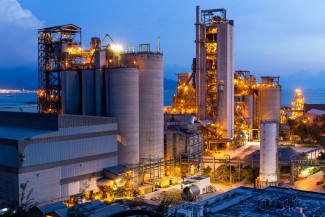Decarbonizing cement and concrete production will be a multi-decade challenge, but strategic public investment decisions today are critical for future success. The Department of Energy (DOE), set to steer billions in new funds toward this sector, faces big choices.
Many assessments by industry and observers emphasize temporary, lower-carbon concrete technologies while effectively banking on a heavy long-term reliance on carbon capture and sequestration. But a better path is available: investing strategically in certain lower-carbon technologies that build toward a multi-step transformation of the sector, ultimately headed toward significant electrification of production. It’s a goal that would be all but impossible for a high-temperature process if we restricted ourselves to focusing on existing materials and techniques.
This strategy—if supported across federal and state investments—could maximize the impact of taxpayer dollars while ensuring that short-term progress is compatible with the best long-term outcomes.
First, use lower-carbon materials geared toward an electrified future
Producers of cement—the key, carbon-intensive ingredient in concrete—already widely use supplementary cementitious materials (SCMs) to reduce costs and carbon emissions. SCMs simply replace some of the clinker—the more expensive and carbon-intensive component of cement—with less expensive and lower-carbon materials. Maximizing the use of these materials could cut emissions from cement production nearly in half and offers an obvious near-term strategy for reducing emissions. But which SCMs are used is key.
The supplies of traditional SCMs—fly ash and slag from coal-fired power plants and blast furnaces from steelmaking, respectively—are dwindling as coal-fired power retires and steel production processes change. Some cement producers are turning to coal ash harvested from landfills and ponds, a seemingly abundant yet finite supply. While this can reduce emissions in the short term, it does not help lead to the critically needed zero carbon production of the future.
More innovative materials offer a bigger opportunity. For example, ground post-consumer glass can take advantage of recycled materials, and calcium silicate rocks enable less carbon-intensive production methods.
Calcined clay, a promising low-carbon technology, could both reduce short-term emissions and enable deeper decarbonization technologies. Clay can be activated using existing cement plant equipment by modifying rotary kilns (traditional equipment for producing portland cement, which uses a slower and longer heating process). But critically, calcined clay could also be produced using flash calciners, an emerging technology to activate materials more quickly and efficiently. And calcined clay can be combined with crushed limestone to offer an effective lower-carbon alternative to clinker. Since limestone calcined clay cement can be produced at a much lower temperature, it could be electrified (discussed below), vastly reducing emissions.
Kaolinite clay (the most suitable type of clay) is abundant in many regions in the United States and is already accepted in industry standards for cement practice and use. Yet because many purchasers are still unfamiliar with it, product supply is only slowly ramping up. Public-sector funding—such as the pending billions in Inflation Reduction Act funds to be dispersed by DOE’s Office of Clean Energy Demonstrations (OCED)—can help overcome substantial business and market barriers by co-funding dedicated clay production facilities and demonstrating their viability to spur additional fully private-funded facilities.
Without government funding, the supply of such innovative materials may not be established with the speed and magnitude needed across the country. The temporarily increasing availability of traditional SCMs could further slow the market acceptance of new materials, which will in turn make manufacturers more hesitant to invest in facilities to produce innovative materials like calcined clay.
Electrification of cement enabled by system efficiency and innovation
Electrifying cement kilns has been challenging because of their high temperature needs. Traditional clinker typically requires 1,500oC to produce. But limestone calcined clay can be produced at only 800oC, a temperature achievable by electric rotary kilns or flash calciners that could be fueled by renewable energy. This electrification could be demonstrated in the immediate years ahead with the right government support. When combined with a continuous clean power supply (enabled with the help of energy storage), electrification could eliminate 40–50% of the cement sector emissions.
Multinational companies are pursuing pilots of these technologies in the European Union and United Kingdom. DOE should consider incentivizing companies to set up demonstrations here. As the grid decarbonizes and as innovative American startups focused on electrification and thermal storage (helpful for these applications) grow, government support is crucial to advance this option now instead of seeing it as a future solution.
Carbon management should be a limited solution
Industry needs multiple tools to decarbonize, and carbon capture, utilization, and storage (CCUS) will play some role. But it should not be a primary option. (One recent industry report suggested CCUS could be used at massive scale to avert fully 36% of concrete production emissions.)
CCUS has immense challenges, including sequestering massive quantities of CO2, the need for pure streams of CO2 (which are unlikely from burning fossil and waste-based fuels in the kiln), and the attendant high costs. It would not eliminate the non-CO2 pollutants that disproportionately burden environmental justice communities and would leave serious long-term concerns about storage and sequestration in underground formations.
CCUS should only be used for a limited portion of the process or industry that cannot be decarbonized through other means, rather than as a way to resist or delay other deep decarbonization solutions like electrification that would limit the creation of new emissions. CCUS allows businesses to continue to rely on fossil energy and limit efforts to address the sources of their emissions. Lastly, captured carbon should be used to manufacture other products instead of merely being stored or sequestered in geologic formations. Federal investment should support research and pilot demonstrations of novel utilization technologies to further advance this use over storage.
Alternative fuels offer limited help
Burning alternative fuels in cement kilns—such as rubber tires, wood chips, and other waste materials—can reduce carbon emissions to a degree. However, using these fuels risks the release of other potentially hazardous emissions that could harm the health of historically disadvantaged communities around these plants. Reducing these pollutants to comply with air pollution rules brings its own costs and liabilities.
Novel solutions need greater public-sector support
Federal and state governments should invest greater effort in facilitating and enabling American companies that are pursuing innovative solutions to decarbonizing concrete. These include companies using artificial intelligence to optimize concrete mix designs, innovative chemistries to advance material efficiency, high-efficiency electric equipment to reduce process heat use, and on-site thermal and battery storage. These solutions should be better integrated into the forthcoming government-incentivized demonstrations. For instance, as OCED prepares to disburse $6 billion in funding, it should consider how to do this in line with the strategic concrete decarbonization we have discussed here.
For ready-to-go technologies, the federal and state governments should help develop market demand by providing incentives, policy support, and technical assistance. Codes and standards development should occur simultaneously. Meanwhile, for earlier-stage technologies, DOE should help evaluate how ready a particular technology is to be implemented or adopted by the market through small pilots. This would keep technologies and jobs in the United States instead of losing them to other countries with better support structures and innovation strategies.




